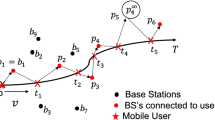Abstract
The complexity of the mobility tracking problem in a cellular environment has been characterized under an information-theoretic framework. Shannon's entropy measure is identified as a basis for comparing user mobility models. By building and maintaining a dictionary of individual user's path updates (as opposed to the widely used location updates), the proposed adaptive on-line algorithm can learn subscribers' profiles. This technique evolves out of the concepts of lossless compression. The compressibility of the variable-to-fixed length encoding of the acclaimed Lempel–Ziv family of algorithms reduces the update cost, whereas their built-in predictive power can be effectively used to reduce paging cost.
Similar content being viewed by others
References
I.F. Akyildiz and J.S.M. Ho, Dynamic mobile user location update for wireless PCS networks, Wireless Networks 1(2) (July 1995) 187–196.
I.F. Akyildiz and J.S.M. Ho, Movement-based location update and selective paging for PCS networks, IEEE/ACM Transactions on Networking 4(4) (December 1995) 629–638.
A. Bar-Noy and I. Kessler, Tracking mobile users in wireless communication networks, IEEE Transactions on Information Theory 39(6) (November 1993) 1877–1886.
A. Bar-Noy, I. Kessler and M. Sidi, Mobile users: To update or not to update?, Wireless Networks 1(2) (July 1995) 175–185.
T.C. Bell, J.G. Cleary and I.H. Witten, Text Compression (Prentice Hall, 1990).
A. Bhattacharya and S.K. Das, LeZi-update: An information-theoretic approach to track mobile users in PCS networks, in: Proc. Ann. International Conference on Mobile Computing and Networking (August 1999) pp. 1–12.
Y. Birk and Y. Nachman, Using direction and elapsed-time information to reduce the wireless cost of locating mobile units in cellular networks, Wireless Networks 1(4) (December 1995) 403–412.
T.X. Brown and S. Mohan, Mobility management for personal communication systems, IEEE Transactions on Vehicular Technology 46(2) (May 1997) 269–278.
J.G. Cleary and I.H. Witten, Data compression using adaptive coding and partial string matching, IEEE Transactions on Communications 32(4) (April 1984) 396–402.
T.M. Cover and J.A. Thomas, Elements of Information Theory (Wiley, 1991).
K.M. Curewitz, P. Krishnan and J.S. Vitter, Practical prefetching via data compression, in: Proc. ACM International Conference on Management of Data (SIGMOD) (May 1993) pp. 257–266.
M. Feder, N. Merhav and M. Gutman, Universal prediction of individual sequences, IEEE Transactions on Information Theory 38(4) (July 1992) 1258–1270.
E. Federovsky, M. Feder and S. Weiss, Branch prediction based on universal data compression algorithms, in: Proc. Ann. International Symposium on Computer Architecture (June–July 1998) pp. 62–72.
J.S.M. Ho and I.F. Akyildiz, Mobile user location update and paging under delay constraints, Wireless Networks 1(4) (December 1995) 413–425.
S. Kahan, A model for data in motion, in: Proc. Ann. ACM Symposium on Theory of Computing (1991) pp. 267–277.
J.N. Kapur and H.K. Kesavan, Entropy Optimization Principles with Applications (Academic Press, 1992).
S.J. Kim and C.Y. Lee, Modeling and analysis of the dynamic location registration and paging in microcellular systems, IEEE Transactions on Vehicular Technology 45(1) (February 1996) 82–90.
G.G. Langdon, A note on Ziv–Lempel model for compressing individual sequences, IEEE Transactions on Information Theory 29(2) (March 1983) 284–287.
G.L. Lyberopoulos, J.G. Markoulidakis, D.V. Polymeros, D.F. Tsirkas and E.D. Sykas, Intelligent paging strategies for third generation mobile telecommunication systems, IEEE Transactions on Vehicular Technology 44(3) (August 1995) 543–553.
U. Madhow, M.L. Honig and K. Steiglitz, Optimization of wireless resources for personal communications mobility tracking, IEEE/ACM Transactions on Networking 3(6) (December 1995) 698–707.
M. Mouly and M.-B. Pautet, The GSM System for Mobile Communications (1992).
D. Munoz-Rodriguez, Cluster paging for traveling subscribers, in: Proc. IEEE Vehicular Technology Conference (May 1990) pp. 748–753.
D. Plassmann, Location management strategies for mobile cellular networks of 3rd generation, in: Proc. IEEE Vehicular Technology Conference (June 1994) pp. 649–653.
G.P. Pollini and C.-L. I, A profile-based location strategy and its performance, IEEE Journal on Selected Areas in Communications 15(8) (October 1997).
J. Rissanen, A Universal data compression system, IEEE Transactions on Information Theory 29(5) (September 1983) 656–664.
J. Rissanen and G.G. Langdon, Universal modeling and coding, IEEE Transactions on Information Theory 27(1) (January 1981) 12–23.
C. Rose, Minimizing the average cost of paging and registration: A timer-based method, Wireless Networks 2(2) (June 1996) 109–116.
C. Rose and R. Yates, Minimizing the average cost of paging under delay constraints, Wireless Networks 1(2) (July 1995) 211–219.
S. Sen, A. Bhattacharya and S.K. Das, A selective location update strategy for PCS users, Wireless Networks 5(5) (October 1999) 313–326.
C.E. Shannon, The mathematical theory of communication, Bell System Technical Journal 27 (1948) 379-423, 623-659, reprinted in: C.E. Shannon and W. Weaver (eds.) The Mathematical Theory of Communications (University of Illinois Press, 1949) pp. 29–125.
J.F. Traub and A.G. Werschulz, Complexity and Information (Cambridge University Press, 1998).
J.S. Vitter and P. Krishnan, Optimal prefetching via data compression, Journal of the ACM 43(5) (September 1996) 771–793.
M.J. Weinberger, J.J. Rissanen and M. Feder, A universal finite memory source, IEEE Transactions on Information Theory 41(3) (May 1995) 643–652.
T.A. Welch, A technique for high-performance data compression, IEEE Computer 17(6) ( June 1984) 8–19.
H. Xie, S. Tabbane and D. Goodman, Dynamic location area management and performance analysis, in: Proc. IEEE Vehicular Technology Conference (May 1993) pp. 533–539.
J. Ziv and A. Lempel, Compression of individual sequences via variable-rate coding, IEEE Transactions on Information Theory 24(5) (September 1978) 530–536.
M.M. Zonoozi and P. Dassanayake, User mobility modeling and characterization of mobility patterns, IEEE Journal on Selected Areas in Communications 15(7) (September 1997) 1239–1252.
Author information
Authors and Affiliations
Rights and permissions
About this article
Cite this article
Bhattacharya, A., Das, S.K. LeZi-Update: An Information-Theoretic Framework for Personal Mobility Tracking in PCS Networks. Wireless Networks 8, 121–135 (2002). https://doi.org/10.1023/A:1013759724438
Issue Date:
DOI: https://doi.org/10.1023/A:1013759724438




